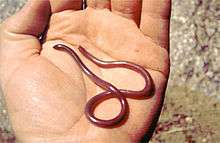Snakes of Europe/Species/Typhlops vermicularis
< Snakes of Europe < SpeciesTyphlops vermicularis, the European blind snake or European worm snake,

is a species of snake in the genus Typhlops, first decribed by Merrem in 1820. Despite its common name, the range of the European blind snake ranges from the Balkan Peninsula, the Aegean Islands, and Cyprus to Afghanistan.[1] The common names refer to how it is the only blindsnake of the genus Typhlops naturally found in Europe.
Biology
Decsribed as growing to 20-35cm in size and being 1cm in diameter. Unlike most relatives, which are oviparous, this species lays 4-8 eggs. It feeds on insect larvae and ants.
Identification
The rostral scale overhangs the mouth to form a shovel-like burrowing structure. They live underground in burrows, and since they have no use for vision, their eyes are mostly vestigial. They have light-detecting black eye spots, and teeth occur in the upper jaw. The tail ends with a horn-like scale. They can often be confused with earthworms as they are both often seen in leaf litter and detritus on the ground, and in the soil.
Venom and toxicity
Described as being willing to try to sting with a small spine at the end of its tail [2].
Alien species
The only other blindsnake found in Europe is the Brahminy blindsnake, or "flowerpot snake," Ramphotyphlops braminus, where specimens have been discovered lurking in the soil at the Kew Gardens, London.[3]